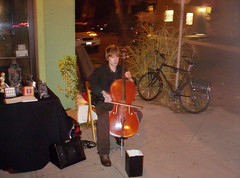Lessons from Portland Oregon

The Cellist, Arts on Alberta Avenue (last Thursday of the month commercial district promotion., Portland, Oregon
A summary of the lessons from Portland Oregon are in this piece, "What We Can Really Learn from Portland," from CitiWire. From the article:
Portland is often held up as such an outstanding model of urban planning–and one that is so difficult to replicate–that you might think it’s somehow different from other cities. But let’s face it: Portland is like any other U.S. city. There are freeways and subdivisions and confusing arterials and big malls and stupid little strip centers.
But there is also a remarkable downtown, a fabulous set of close-in neighborhoods, a remarkably large and diverse transit system for a city Portland’s size, and an emerging ethic that is comfortable with being an urban place.
Rather than simply thinking there’s no way to copy Portland–or that all cities must slavishly follow the Portland model–it’s worth thinking about Portland’s DNA. Why does Portland do things–and do them successfully–that a lot of other cities can’t seem to do? ...
1. Portland has great raw material
2. They’re not afraid to just build stuff
3. They never stop thinking about the actual walking experience
4. They keep reinforcing the connection between development and transportation
5. They keep strengthening the informal aspects of city life
6. They’re not holding out for perfection
------
I have a blog entry from October 2005, "A summary of my impressions of Portland Oregon," which covers the same ground. It also quotes from Portland's Downtown Plan from 1972, where many of these precepts (except for 2 and 6) were laid out.
Here are the lessons I came up with:
1. Urban growth boundaries and state planning requirements are essential to keeping growth compact and centered, utilizing preexisting infrastructure, and maintaining the worth of extant land and buildings, rather than the typical metropolitan area which experiences development further and further out, and where the politics and the economics of the region tend to be disconnected from the issues and needs of the center city.
2. People with vision and commitment to more than just making money are essential to keep assets grounded in historic preservation and the other qualities that promote livability.
3. Continued focus on development of the core.
4. Jane Jacobs says that one of the four key factors to successful center cities is a large stock of old buildings. She said this not because she is a preservationist, but because buildings that have been paid off cost less to rent, and therefore are natural incubators of innovation. Be it retail, industrial, or service, all can be accommodated in such buildings.
5. Active streets and mixed uses are maintained through most city policies.
6. Transit investment is substantive and continues.
If you want to see what Portland looks like, and a trip there isn't yet in your plans, the "second best" alternative is to check out the website Portland Ground and its scads of fabulous photos.
Labels: change-innovation-transformation, sustainable land use and resource planning, transportation planning, urban design/placemaking, urban revitalization



0 Comments:
Post a Comment
<< Home